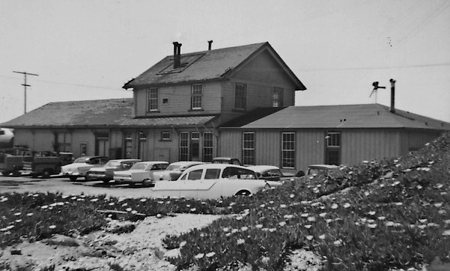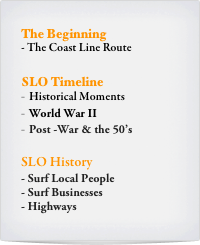Southern Pacific Lines
Coast Line Division
“The Route of the Octopus”

Southern Pacific Lines
Coast Line Division
“The Route of the Octopus”

What’s at Surf?
Nothing but the wind, the sand and the sea.
John Roskoski
The Beginning
The Coast Line Route
The area in between the coastal lands of Santa Barbara and San Luis Obispo Counties was called the “gap”. SLO - S.B. is the “stormy end”.
There was an early survey ~1890's when SP was still building. The inland route was surveyed but SP chose the coastal route - several years before Hoyt S Vandenberg was born and long before missiles the way we think of them now.
Bruce Morden
S.P. Facilities
Surf had an extensive water treatment plant north of the station to produce soft water. Steam power turned to diesel and thus no need for soft water and heated bunker fuel.
There is a wye turnaround between Surf and Ocean Park, just before the Santa Ynez Bridge.
3 old car bodies used for housing placed there during WWII. Located south of roadmasters house. Two of the bodies hung out over the cliff and the ocean. Roadmasters house had a tower for AM radio antennae to pickup LA and SF.
Surf TimeLine
Historical Moments
1896 - The first train reached Surf.
1899 - The first train reached the Lompoc extension in June 1899.
1900 - Surf Depot opened
1901 - President John McKinley road through Surf. It was the first presidential train to the Pacific coast. (*see Bulletin 1901)
1903 - President Teddy Roosevelt visited Surf in 1903.
1913 - Surf renamed Lompoc Junction
1921 - Lompoc Junction renamed Surf
1924 - Lompoc extension to Celite completed
1928 - F.D.R. toured the Coast Line (*see Bulletin 8/1928, pg. 8-9)
1941 - NBC Sammy Kaye Serenade
Navy beans sold from 2 cents to 33 cents
1941 - “Montebello” - Union Oil Tanker torpedoed (December 23) by Japanese sub off coast near Cambria
1942 - A Japanese submarine fired shots at Ellwood Oil Field on Feb. 23, .
1942 - Executive Order 9066 forces relocation of 800 County residents of Japanese ethnicity
Blackout drill - 3 short and 1 long blast, and the street lights would dim
1943 - Due to wartime priorities, all train travel must be booked five days in advance.”
1950 -
1957 - Soviet Premier Nikita Khrushchev rode the Coast Line on Sep. 20,
1958 - Trains south from S.F. carried up to $5 million of military payroll.
1981 - Three trains collided and 70 cars were derailed,
1985 - The Surf Depot was abandoned.
Surf
Earliest History
Chumash Indians lived in this area.
Early History
Long after Southern Pacific began San Francisco-to-Los Angeles service in 1876 via Tehachapi, the Pacific Coast route waited for completion. It reached north from Los Angeles to Elwood in 1887, but south from San Francisco tracks ended north of Cuesta Pass. Stage coaches ferried passengers between the railheads. Chinese laborers worked on Cuesta Grade for three years before continuing south, towns along the route bargained for the new route. Santa Ynez city fathers wanted it to run to Buellton and Gaviota. Lompoc citizens wanted it to come in from Surf, then south over the San Julian. Neither got their wish as the company finally elected to build nine trestles and run its rails along the coast.
Surf was settled in 1896 when SP’s bridge over the Santa Ynez River was completed. Finally Southern Pacific's rail system reached Surf in 1896, and in June 1899 the extension into Lompoc was complete.
Surf depot went up in 1900 as SP’s final gap to the south was closed the last day of the year. In March 1901, passengers could depart the Lompoc station at 4:20 a.m. for the south.
By 1901 the entire coast line was complete, with Surf becoming a small town to accommodate the manpower needed to maintain the trains and tracks. It was a lonely, windy, fog-shrouded Southern Pacific railroad depot at the 302-mile marker, south of San Francisco.
There were visits by railroad magnate Collis P. Huntington and President Theodore Roosevelt.
In 1913, due to lobbying from Lompoc, Surf became known as Lompoc Junction, but in 1921 it won back its name. Southern Pacific refused to extend its Lompoc line to Celite’s mine and mill in the hills to the south until an independent corporation threatened to build its own tracks. Only then did SP give in. It was 1924.
There were steps to the beach at Surf built in the 20’s. The steps were built by the Civic Club of Lompoc securing a lease from the SPRR.
Oil well explorations were conducted at Aloha Beach behind the town of Surf in the 30’s.
Mid- History
Surf, which at its peak had a population of 40, its own post office and general store. The Morinini family ran the general store and gas station. Box car bodies that were used to house section hands.
Trains modernized, the town shrank, and plans for a resort development named Aloha Beach never managed to stay afloat.
When Vandenberg Air Force was created there were train problems during missile launches. Surf is probably the only station in the country that had a bomb shelter. When a missile was to be launched everyone had to leave the area except for the agent. At launch time he had to go in the shelter. All trains also had to be out of the area and this caused extended delays if something happened to change the countdown. There was a study made to reroute the mainline from the Guadalupe area east towards Buellton and back to the mainline at Gaviota.
Horace Fabing
The population in Surf was 100 during 1950, and was half that in 1960.
At least in the mid-60s, there was a nice wooden stairway down to the beach in front of the depot area. Sadly, it is no longer there.
Tom Cockle
That siding spent a lot of time out of service. Every time they got a big storm with high surf, it tended to get washed out or get sand covering the track!
Peter Arnold
Late History
By 19__, Surf, the town was gone, leaving only the telegrapher's station. Southern Pacific could send orders and track information to the station telegrapher, who would attach the messages to a post next to the tracks, where train conductors and engineers, moving as fast as 70 mph would grab the messages, attached to loop cords, with their bare hands.
Even as radio communication directly to trains improved, Point Conception offered enough interference from Los Angeles that Surf's telegraphers stayed at their post longer than most of their peers.
Bob Wolfe was personally responsible for closing down the agency at Surf. Warren Christiansen worked at Surf for 37 years and was the last one to turn the key in 1985. He started work as a call boy, responsible to call the train crews for work, later a relief yard clerk.
The last four telegraphers one-time Hells Angel Sid Coffman and also the town's last resident; electronics guru Chris Christensen; Glenn Trussell, a poet; and Frankie Vasquez.
The day came though - March 1, 1985 - when the last order came, and the windows were boarded up. The depot was abandoned in 1985, then demolished.
Surf today consists of little more than three sleek and modern commuter shelters at the ocean end of Highway 246.
CTC
During WWII, the war effort caused CTC installation a priority, so in early 1942, 16.6 miles of single track mainline over Cuesta Pass on the Coast Division was converted to Centralized Traffic Control. CTC and completed in 1942. In 1954 a CTC machine was installed (*see CLP-132, 133).
CTC machine controlling movements over the Cuesta Grade moved from SLO to the Coast Division Hdq.. in SLO (3rd & Townsend) Nov. 1, 1957.
One dispatcher was responsible for the entire Coast Line from S.F. to S.B.
Spring of 1960 agencies closed all over including Gaviota.
Manual train sheets (train position vs. time) (*see CLP-133.
End CTC sign in SLO(*see CLP-123)
1942 CTC installed, limits yards west of SLO depot to Santa Margarita Depot
CTC limit signs “end CTC” white with black letters.
Train-Order at Surf
Surf had a train-order and facilities. In 1953, the “Mail” if on time, arrived at 10:28 A.M. for a brief stop to exchange mail and express for Lompoc. The local out of Santa Barbara would work the Lompoc branch and the diatomaceous-earth processing plant a few miles beyond White Hills.
Church’s Daylight, pg. 223.
Radio Equipped Radio Cars and teh S.P.
Two-way radios began with freight service on the LA to Watsonville run in 1950. Radio Cars on passenger service, were to be positioned in their right place in the train.
A radio was installed at Surf in 1958. However its ability to talk to trains was limited to Arlight to the east and Narlon to the west. The general ability of the train dispatcher to talk to trains was still 10 years away and another 25 years before trains would be controlled by radio conversation between the engineer and the dispatcher.
References
“Surf and the Southern Pacific”, article, by John Roskoski, Trains Magazine, March issue
Surf's history, from startup town, military depot, to its current role as an Amtrak commuter station.
"Three feet wide, 120 feet deep", article, by John Roskoski, Trains Magazine, Jan. 1991 issue
The Road by Jack London
Lonesome Traveler, Jack Kerouac, 1960
H mentions Surf along with Tangair and Gaviota
A great source of information is the Lompoc Valley Historical Society.
SLO History
Surf Local People
hobo Wilbur Jones
Morinini Family
telegraphers Robert Wolfe
Dale
Chris Christensen
Glenn Trussell
Frankie Vasquez
Sid Coffman
Surf Businesses
Morinini General Store
Henry P. Morinini had a general store next to the Surf depot during the 20’s & 30’s. He even sold Union Oil gasoline. His home was directly behind the depot. He had two daughters, Margaret and Theodora. He also raised goats. In 1942, the U.S. Army and Camp Cooke moved in and Mr. Morinini moved to Tajigus.
Highways
Highway 246
To the Lompoc.
Vandenburg Air Force Base
Camp Cooke
Prior to Vandenberg AFB the area north of Surf was the army Camp Cooke dates back to 1941 when it served as a training facility for armored and infantry troops. Troops from Camp Cooke boarded at Surf. Military prisoners were put in jail cars at Surf. During the war a U.S.O. building was built for the enlisted men. Dancing was with the cooperation of the ladies of Lompoc.
During the war, the loop then was used for troop trains and the shipment of military supplies including tanks. At the time there was an armored tank outfit training there. The SP operated the troop trains. When the war was over the camp was shutdown.
Vandenburg Air Force Base
After the war, Camp Cooke became Vandenburg Air Force Base .The south portion of Vandenberg AFB, just south of Surf, was called Point Arguello Naval Air Station. They referred to it as south Vandenberg. The Navy missile base was taken over by the Air Force in 1964 when it was integrated into Vandenberg. There is a launch facility about two miles south of Surf. They added miles of track for there operations.
There was a fallout shelter was located in the sand dune just north of the depot for rocket launches at Vandenburg Air Force Base for railroad personnel. SP’s Surf station is probably the only station in the country that had a bomb shelter. When a missile was to be launched everyone had to leave the area except for the agent. At launch time he had to go in the shelter. All trains also had to be out of the area and this caused extended delays if something happened to change the countdown.
Trackage
The main track into Camp Cooke went to what is now the Vandenberg headquarters area and came off the Southern Pacific at the Tangair Wye. Most of this track has now been removed.
If you look at the map you will notice a spur taking off southbound and making a 180 degree curve up the hill to the facility It is at least a 3 percent grade. The section of track at the south end of the base with the steep grade and 180 degree turn back is actually more recent and was constructed for Space Launch Complex 6 (SLC-6) which was constructed for launches of the Space Shuttle. This launch area is still in use including rail deliveries.
Here is view of the railroad loop track, right off the Coast Line near Casmalia CA
Tim O'
The loop of tracks was originally built for a mobile deployment of the MX or Peacekeeper missile. Current use of the tracks in the satellite view, and the do appear well maintained. Evidently there was another spur that ran into the main industrial portion of the base and served by the SP.
See the news release at http://www.vandenberg.af.mil/news/story.asp?id=123102138
John Barry
The loop at the north end of the base was added later, although there was a spur off the main at Marshall where there was a sugar beet loader. There is still a connection to the SP main line just railroad west of Narlon. You can see the spur from the train if you know where to watch.
Bruce Morden
Rail Garrison Cars
Here are a few photos of the Rail Garrison train and cars. The photos of the train inside the shelter were taken at Vandenberg AFB. The Rail Garrison program has been abandoned, and photos such as these are unclassified.
Don Strack
If you scroll down in the Wikipedia article under 'deployment' there is a photo of a garrison car for the missiles.
One of the missile launch cars is on display at the USAF museum in Dayton, OH. Page about the car:
http://www.nationalmuseum.af.mil/factsheets/factsheet.asp?id=788
A photo set of WECX 1002: http://www.csxfan.railfan.net/dodx/WECX1002.html
Another car is USAX 90051 / TBCX 90051: http://www.rrpicturearchives.net/showPicture.aspx?id=1317237
Both were pulled by SP locomotives at some time.
Robert Simpson
Flora & Fauna
In the area is Surf beach and Ocean Beach, both home to the Western Snowy Plover, endangered bird species. The area is known as a Pacific flyaway zone for migratory birds.
Steelhead trout (Steelhead Salmon) were in abundant supply in the Santa Ynez River before Bradbury Dam at Cachuma Lake was built in 1953.
Cypress trees surrounded some of the housing with white picket fences.



